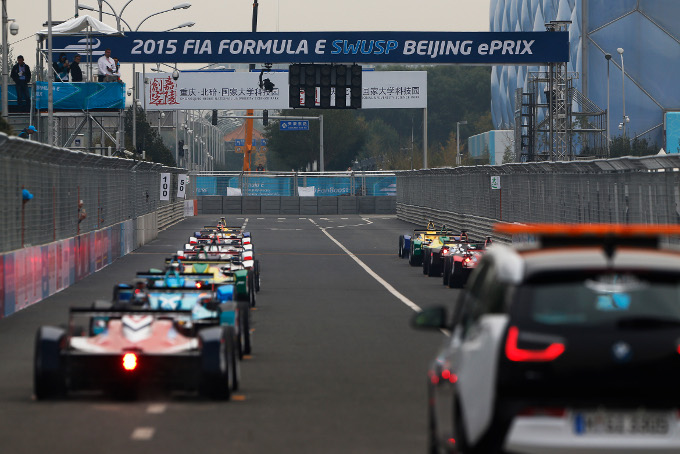Formula E commentator looks at the key talking points from the first race of the season.
1. Renault e.dams and Buemi the combination to beat
Having had a hand in the construction of the original Formula E car, it was clear Renault would have been planning its manufacturer entry for some time, and it showed. Sebastien Buemi dominated the race in Beijing, becoming the first driver in Formula E history to take pole position, set fastest lap and win the race. After missing out on last year’s title by one point, the Swiss is clearly fired up to go one better. On a circuit that was owned by his team-mate Nico Prost last season, Buemi proved a point in Beijing.
2. DS Virgin and Abt Schaeffler the closest contenders
Renault will not have it all its own way though. After an eye-opening Friday test session, where the French outfit were two seconds clear, Lucas di Grassi in the Abt Schaeffler machine showed some strong pace. In fact, the Brazilian’s FP2 time was marginally quicker than Buemi’s pole lap. Were it not for a mistake at Turn 1 in the Super Pole shoot-out, we could well have had an Abt on the front row. As for DS Virgin, its pure pace seems reasonable, and appeared to be the third team in the hunt for glory. But in the race, both Jean-Eric Vergne and Sam Bird struggled with energy efficiency, and had to dramatically back off to make it to the pitstops. Seventh for Bird and 12th for Vergne was a disappointing result, but the potential is surely there for more.
3. NEXTEV TCR needs to make progress
It was a horrible weekend for reigning champion Nelson Piquet Jr. The Brazilian had reliability problems in practice, not helped by an apparent pit limiter failure which sent him into the wall before the pit exit! After only managing 12 laps in practice, qualifying was a struggle and he lined up last on the grid. Team-mate Oliver Turvey completed 28 practice laps, but still only had the pace for 15th on the grid. The race didn’t work out much better for Piquet, but Turvey managed to score points, albeit helped by a fortunate Full Course Yellow during his pitstop. There’s a lot of work to do for NEXTEV.
4. Impeccable reliability
As was the case the year before, the paddock was full of guessing games about how many cars would finish the race. With the new tech, there were big reliability questions. Indeed, the teams running last year’s powertrains were rubbing their hands with expectation, feeling they were destined to score some points as all the new powertrains broke down. They were left disappointed. No cars retired with mechanical failures, and the highest place finisher with last year’s motor was Nathanael Berthon for Team Aguri in eighth place. On the flip side, this shows the progress that the new powertrains have made, with the fastest old-spec lap being 2.5 seconds slower than Buemi’s quickest race lap.
5. FanBoost can change rapidly
It was amazing to see how quickly the FanBoost standings changed on race day. When we woke in Beijing, Sam Bird was fourth in the standings with 14 per cent of the vote. By the time the race came, he ended up winning FanBoost with 30 per cent of the vote! It shows how quickly the standings can swing, and with voting now ending six minutes into the race, we could well see more dramatic changes in the voting as the season progresses.
6. It’s great to be back
Now, all eyes turn to Putrajaya. It’s a very different circuit to Beijing, much more flowing, no chicanes, which may well provide a change in the running order. Renault will no doubt remain the team to beat, but Abt, DS Virgin and the rest of the pack will be desperate to overhaul them.
